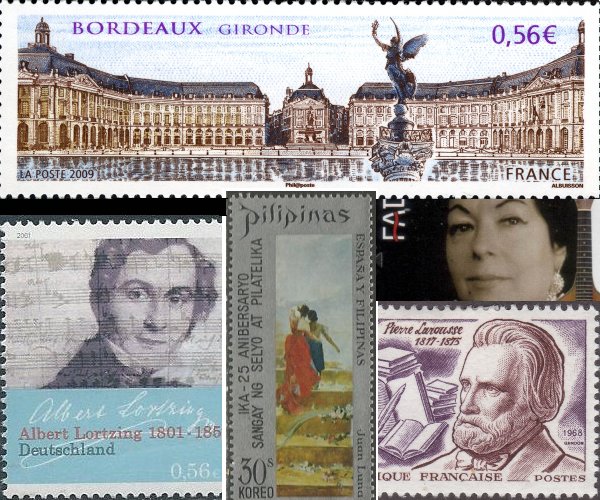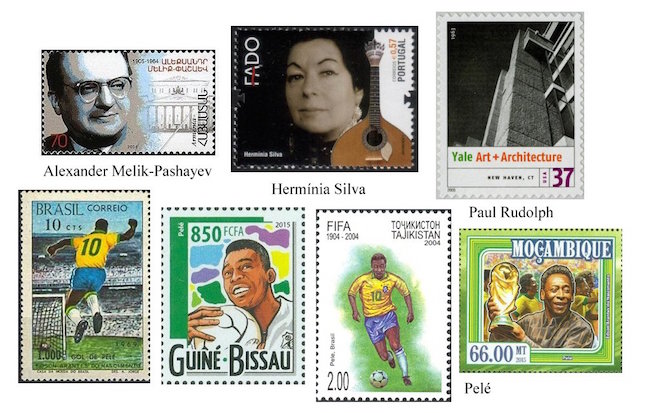The Arts on Stamps of the World —October 23
An Arts Fuse regular feature: the arts on stamps of the world.

By Doug Briscoe
Two architects, one old, one new, a composer, a lexicographer, two painters, a conductor, a fado singer, and Pelé, who has done some acting and composing, are today’s fare on The Arts on Stamps of the World.
Ange-Jacques Gabriel (23 October 1698 – 4 January 1782) succeeded his father Jacques Gabriel (1667–1742) as first architect at Versailles (tantamount to be being first architect in France) in 1742. While still serving as his father’s assistant he had begun work on the Place de la Bourse in Bordeaux, a structure that was 45 years in the making (1730-75). It is shown on a splendid, broad stamp of 2009. Gabriel was also responsible for the façades for the north side of the Place de la Concorde (at the time Place Louis XV), built from 1754 to 1763 and, perhaps most famously, Versailles’ Petit Trianon (1762-68).

German composer Albert Lortzing (October 23, 1801 – January 21, 1851) was born to itinerant actors, so he knew the theater from an early age, first appearing on stage at 12. He himself sang in the première of his first comic opera Zar und Zimmermann (1837). He worked as Kapellmeister in Leipzig, Vienna, and Berlin and died of a stroke at age 49.
Though not an artist per se, we salute the great lexicographer and encyclopedist Pierre Larousse (October 23, 1817 – January 3, 1875) on this the two hundredth anniversary of his birth. The name will be de rigueur to anybody who has studied français at l’école. (“Écoutez…et répétez.”) The son of a blacksmith, Larousse won a scholarship at 16 at the teaching school in Versailles and himself became a teacher. Chafing at archaic methods, he and colleague Augustin Boyer founded a bookshop and published progressive textbooks and manuals for both children and teachers, and in 1856 they published a dictionary that was the precursor of the Petit Larousse. An even grander project was the expanded encyclopedic Grand dictionnaire universel du XIXe siècle (Great Universal 19th-Century Dictionary), the first volume of which appeared in 1863. In 1869 Larousse took up the task single-handedly and worked on it for the rest of his life. It was completed just after his death by his nephew Jules Hollier.
The rather hot-tempered Filipino painter Juan Luna (October 23, 1857 – December 7, 1899) was also actively involved in the Philippine Revolution, but well before that he had succeeded in the arts. He and his brother Manuel went to Europe in 1877 for further education, Manuel in music, Juan in painting. (The great polymath and patriot José Rizal was apparently of the opinion that Manuel was the better painter.) One of Juan’s pieces earned a silver medal at the Exposición Nacional de Bellas Artes (National Demonstration of Fine Arts) in Madrid in 1881, and another took a gold medal three years later. He was well on his way to becoming one of the first internationally recognized Filipino artists. On discovering that his wife was being unfaithful—this is the hothead part—Luna murdered her and his mother-in-law and wounded his brother-in-law in 1892. A plea of “crime of passion” got him off the hook. Then he was arrested again in 1896 for his association with a rebel army but received a pardon the next year. He was eventually rewarded by the new revolutionary government with a diplomatic post, first in Paris, then in Washington, D.C., where he worked for official recognition of the new regime. He was on his way back back to the Philippines for his murdered brother’s funeral (a long story) when he succumbed to a heart attack in Hong Kong. Two stamps show Luna’s paintings (he was also a sculptor): Spain and the Philippines (1886) and Una Bulaqueña (Woman from Bulacan, 1895). Another prize-winning piece, commissioned by the Spanish Senate, is his Battle of Lepanto of 1897. And I’m rather partial to Odalisque (1885).
Today’s other painter is our next subject. The Canadian Lawren Harris (October 23, 1885 – January 29, 1970) was born to a wealthy family whose affluence allowed him to pursue his love of art. At 19 he furthered his education in Berlin. Back in Canada he met J. E. H. MacDonald in 1911, and together they founded the Group of Seven. With his resources, Harris helped finance a studio for the group in Toronto. When it disbanded in 1933, Harris and other members created a new association, the Canadian Group of Painters. It was around this time that Harris undertook a journey to the Arctic, where he made sketches he later developed into his last landscapes; after that he turned to abstraction. Last year a television documentary of his life, Where the Universe Sings, was produced. The stamp from 1967 shows one of the canvases he executed of a favorite topic, Bylot Island (c1930). Links to two further examples are here and here.

Soviet-Armenian conductor Alexander Melik-Pashayev (23 October 1905 – 18 June 1964) studied with Nikolai Tcherepnin and Alexander Gauk and became chief conductor at the Tbilisi Opera in 1930. Although best known as a conductor of the Russian operatic repertoire, he made a point during his tenure at Tbilisi of performing Western works as well. He also conducted at Covent Garden, where he gave Verdi’s Aida with Galina Vishnevskaya (whose birthday is the day after tomorrow). He made a number of recordings for Melodiya in the 1940s and 50s, some of which—Borodin’s Prince Igor, Glinka’s Ivan Susanin (A Life for the Tsar), and The Demon by Anton Rubinstein—have been made available on Naxos CDs.
One of the most renowned of fado singers was Hermínia Silva (1907 – 13 June 1993). She sang in local venues in her native Lisbon before hitting it big in the late 1920s. She began making recordings in the next decade and also began to appear (singing) in film, usually comedies. The stamp is one of a set that recalls popular fado singers.
Our second architect today is Paul Rudolph (October 23, 1918 – August 8, 1997), born in Kentucky 99 years ago today. Also interested in painting and music, Rudolph earned a BA in architecture in Alabama and came north to study at Harvard under Walter Gropius. In later years he would produce a lot of work in Massachusetts: the Government Service Center building, the new First Church in Boston (reconstructed after the fire of 1968), the Jewett Arts Center at Wellesley College, and the main campus of UMass Dartmouth among them. His most famous work, though, is the Yale Art and Architecture Building shown on the stamp. Rudolph became chairman of the school in 1958, shortly after designing it. Another quite interesting structure is the Arthur Milam House in Ponte Vedra, Florida.
It’s not often we acknowledge sports figures here, but as I said above, Brazilian soccer star Edson Arantes do Nascimento (born 23 October 1940), universally known as Pelé, has also composed music (e.g., the soundtrack for the film Pelé, 1977) and done a bit of acting, most notably in 1981’s Escape to Victory with Michael Caine, Sylvester Stallone, and Max van Sydow. Much more significantly, though, Pelé is hailed by many as the world’s greatest footballer. The International Federation of Football History & Statistics (IFFHS) named him World Player of the Century in 1999 and cites him as the highest ranked goal-scorer, with 1281 goals in 1363 games. Named for Thomas Edison, Pelé was appointed UN ambassador for ecology and the environment in 1992.
Britain, you should pardon the expression, drops the ball again, philatelically ignoring poet laureate Robert Bridges (23 October 1844 – 21 April 1930).
A graduate of the University of Massachusetts with a B.A. in English, Doug Briscoe worked in Boston classical music radio, at WCRB, WGBH, and WBUR, for about 25 years, beginning in 1977. He has the curious distinction of having succeeded Robert J. Lurtsema twice, first as host of WGBH’s weekday morning classical music program in 1993, then as host of the weekend program when Robert J.’s health failed in 2000. Doug also wrote liner notes for several of the late Gunther Schuller’s GM Recordings releases as well as program notes for the Boston Classical Orchestra. For the past few years he’s been posting a Facebook “blog” of classical music on stamps of the world, which has now been expanded to encompass all the arts for The Arts Fuse.
